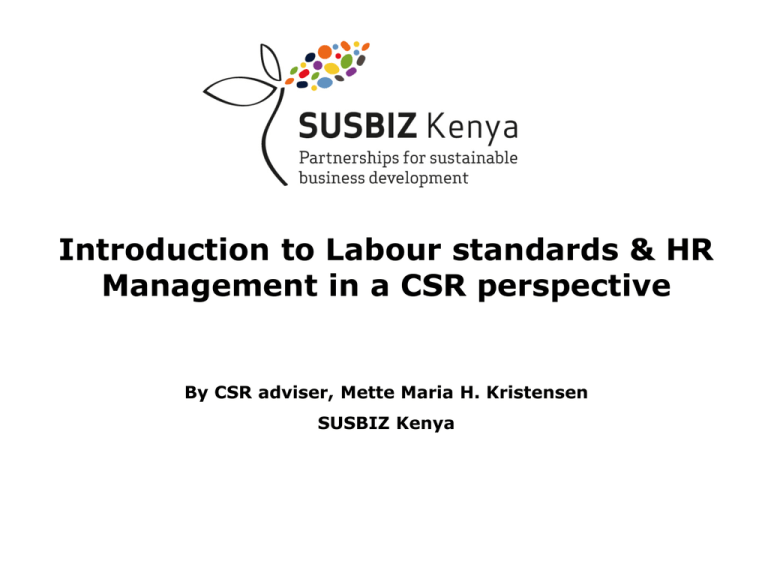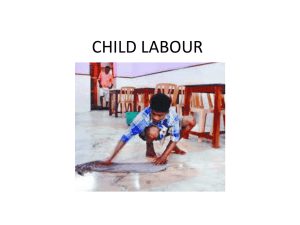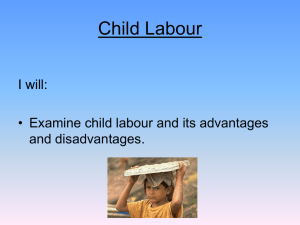
Introduction to Labour standards & HR
Management in a CSR perspective
By CSR adviser, Mette Maria H. Kristensen
SUSBIZ Kenya
Agenda
1. What is Labour standards
2. What is HR Management
3. Labour standards and HRM in a CSR
perspective
4. Strategic HR Management
5. Examples from the medias
6. Short exercise
1. What is Labour standards
“Core Labour standards are a series of rules and
principles regarding the minimum standards recognised
by the international community for treating workers
humanely”.
”Although many kinds of Labour standards exist, the
ones referred to as the four core Labour standards are
those that the international community has agreed are
applicable to all countries because they protect basic
human rights”.
OECD – Organisation for Economic Co-operation and
Development.
ILO – International Labour Organisation.
The 4 core Labour standards
– Elimination of forced and compulsory Labour
Forced Labour is all work or service which is exacted from any person under the
menace of any penalty and for which the said person has not offered himself
voluntarily.
– Abolition of child Labour
Aside from violating children’s basic human rights, sending children to work rather
than to school perpetuates poverty and compromises economic growth.
– Elimination of discrimination in respect of employment and occupation
Discrimination includes any distinction, exclusion or preference made on the basis
of race, colour, sex, religion, political opinion, national extraction or social origin,
which has the effect of nullifying or impairing equality of opportunity or treatment in
employment or occupation.
– Freedom of association and collective bargaining
The right for workers and employers to freely create and participate in
organisations to promote and protect their interests. Signatories must give workers
and employees the right freely to establish and join organisations of their choice,
without any type of prior authorisation. Signatories further agree to establish
mechanisms to ensure the right to organise and to encourage the practice of
negotiating between employers and workers’ organisations.
2. What is HR Management
“The administrative discipline of hiring and
developing employees so that they become
more valuable to the organisation”.
”Activities that management engage in to attract
and retain employees and to ensure that they
perform at a high level and contribute to the
accomplishment of organisational goals”.
OHS vs. labour-activities
Occ. Health and Safety
• PPE
• First aid
• Fire safety
• Industrial hygiene
• Machine safeguarding
• Safety committee
• Physically demanding work
• Injuries, illnesses
• Hazardous materials
• House keeping
• OHS training and audit
• OHS Management system
/policy
Labour and HR
• Recruitment
• Contracts of employment
• Child Labour
• Wages
• Non-discrimination
• Freedom of association
• Working hours
• Retention
• Insurance
• Dormitory housing
• HR training and audit
• HR Management system
/policy
1. HR Management tools
•
•
•
•
•
•
•
•
Performance management and evaluation
Coaching
Mentoring
Team building and management
Staff development interviews and training
Personality and qualification test
Workplace assessment
Management systems: OHSAS 18000 &
the SA8000 standard.
3. Labour standards and HRM in
a CSR perspective
• When HR management is strategic CSR the HR
activities often goes beyond following the Labour laws
and benefit your employees in a way that also benefits
the company’s performance and bottom line.
• Legal requirements: social security, workers
compensation, work assessment etc.
• Voluntary activities and benefits: extensive health
insurance, retirement, day care etc.
• The objective of strategic HRM is the development of a
HR system that enhances the organisations efficiency,
quality, innovation, and responsiveness to
customer needs and demands.
4. Strategic HR Management
Strategic HR Management
Strategic HR Management
•
•
The positive effect on competitiveness and bottom line is
particularly strong among businesses that have offered their
employees continuing education, skills development and/or retraining and improved physical and psychosocial working
conditions.
The services offered by the company depend on the
employees’ performance. Good physical and psychosocial
working conditions result in
improved employee welfare, and therefore
improved performance, which ultimately shows on the bottom
line.
The skills and abilities of businesses have often evolved from
experience. Therefore, it is often an advantage to retain older
employees with core competences, enabling the business to
maintain this experience in the business as long as possible
and, in that way, optimize performance.
Example: Strategic HR Management
HOLM NIELSEN A/S is a Danish company offering work and
services within a variety of building sector segments. The company
has about 40 employees.
Strategic HR Management: Works actively to prevent social
exclusion by hiring marginalised groups and pursuing a “soft” staff
policy where the individual employee is at the centre of attention.
”If you give people a chance, that’s something they
remember. This means our social responsibility lays the
foundations for talented and loyal employees. And when
the employees are dedicated to their work, it improves
performance in bottom-line terms”.
Kurt Holm Nielsen, owner.
Strategic Labour standards
”A number of studies find no evidence to
support the belief that multinational
enterprises favor countries with lower respect
for basic human and worker rights. On the
contrary, evidence suggests that multinational
enterprises are more likely to invest in
countries with stricter safeguards and
enforcement of basic human and worker rights
than in those countries where such rights are
absent or poorly enforced”.
OECD
Strategic HR Management
• Reduced absence due to
sickness among employees
as a result of a health
policy.
• Employee satisfaction can
pave the way for a lower
rate of employee turnover,
strikes/go-slow and lower
expenses for recruitment
and advertising.
• Reduced sickness absence
among employees, which is
a direct financial benefit.
• Reduced number of
overtime hours and rejected
products.
5. Examples from the media
•
•
•
•
January 2012: Agnes Cupcakes has
illegal employment contracts and lying to
customers saying old cakes are fresh.
February-March: Fine, hire PR agency,
more media attention and apology from
management.
April: Main investor pulls out.
May: Change name and
close to going bankrupt.
Examples from the media
• Café Summershoes is a trendy CPH restaurant.
• June: 20 activists showed up and blocked the
cafe entrance as a protest against:
–
–
–
–
No extra payment for overtime, holidays, weekends.
Unknown working hours
No payment for intro. and probation periods
No collective agreement and union
Examples from the media
• The owner of Café Summershoes is denying the
allegations and has reported the activists to the
police.
“The employees sign a employment contract and
they know that the probation period is not paid.
We have monthly meetings with the employees
and they do not complain. My employees are
happy otherwise they would not be able to give
the customers a good service”.
Bahram Sari, Owner
Examples from the media
•
•
•
•
•
•
Gertrude’s Children’s Hospital on the news last Friday
and Saturday the 9th of May:
Doctors want to join new private union (KPMDU).
Gertrude’s management refuses because union has
not engaged through the Private Hospitals Association.
38 doctors went on strike on Saturday.
The strike is illegal according to a court ruling.
Legal action will be taking with doctors on strike.
An employee complains that her contract was changed
from a permanent to short term contract because she
is pregnant – Gertrude’s denies the allegations.
Questions ?
2. Short exercise
Take 10 min. and discuss with the person next to you:
•
How and why does your company work with Labour
standards and HR management?
•
How does your company find out about new Labour
laws and regulations?
Does your company have a HR policy?
Who is responsible for HR activities in your company?
•
•







